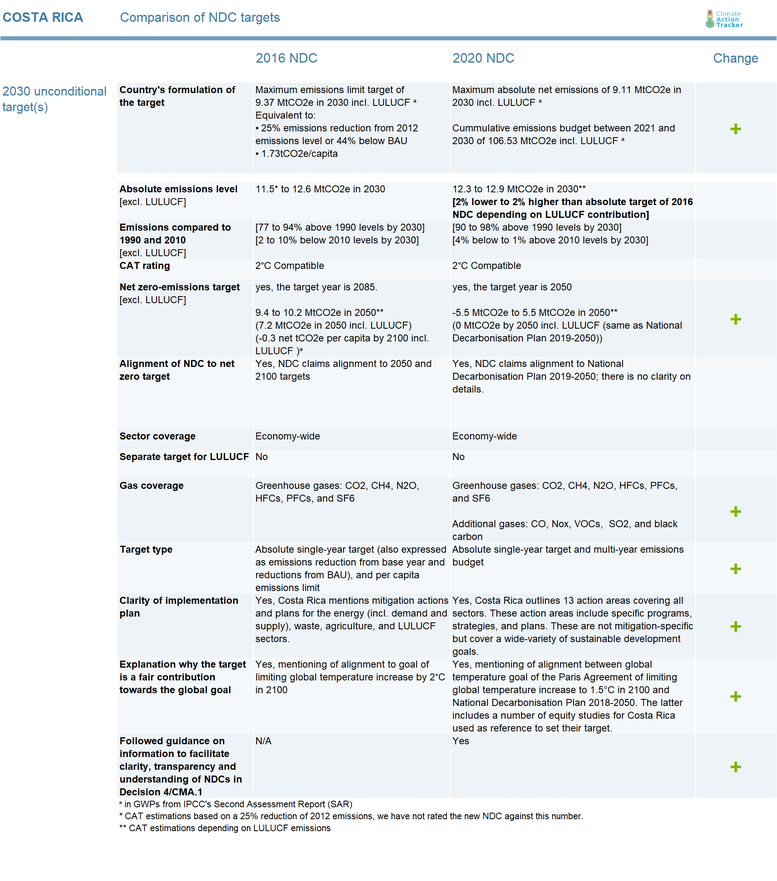CAT Climate Target Update Tracker
Costa Rica
Summary
Costa Rica’s updated NDC, submitted on 30 December 2020, includes two unconditional targets: an absolute single year 2030 emissions target, and a multi-year emissions budget for 2021 - 2030. The absolute emissions target is a little more stringent at face value but translates to a 2% lower to 2% higher difference from the first NDC’s absolute target depending on expected emissions from forestry. Costa Rica’s first and updated NDC are among the few that are rated 2°C compatible.
Costa Rica’s NDC outlines various sectoral measures and targets but fails to specify the sectoral breakdown. Specifying the sectoral breakdown or at least the contribution of the forestry sector to its target would improve the climate target’s transparency. Costa Rica’s NDC claims to be 1.5°C compatible, however this is not substantiated in its submission.
CAT analysis of NDC


Costa Rica’s 2020 NDC submission includes a maximum absolute net emissions target that is a little more stringent. When the forestry sector is excluded, it is 2% lower to 2% higher than the 2016 NDC’s absolute emissions target, depending on the contribution of the LULUCF sector.
Costa Rica has improved on the architecture of its NDC target. In comparison to its previous NDC, which already had an absolute emissions target, Costa Rica has strengthened its ambition and the transparency of the target by adding an emissions budget. A detailed emissions pathway for the period 2021 - 20301 would further improve the transparency of its climate commitments even further.
The CAT rating for Costa Rica remains 2°C compatible. We have estimated this target as a range of 12.3 to 12.9 MtCO2e in 2030 excl. LULUCF, though there is some uncertainty in this estimate due to a lack of details on the contribution of the forestry sector (for further details see the Assumptions section below).
Costa Rica claims that its updated NDC is aligned with its net-zero target. However, the submitted target does not match the 2030 emissions value for the 1.5°C scenario from the National Decarbonisation Plan. To align with its proposed 1.5°C scenario, total emissions excl. LULUCF in 2030 would have to be 1.1 to 1.7 MtCO2e lower. Details and transparency on how the NDC is aligned to its National Decarbonisation Plan pathway would be useful.
The CAT’s own fair share analysis shows that Costa Rica’s 2030 total emissions excl. LULUCF should be limited to 10.6 MtCO2e to be 1.5°C compatible. Costa Rica claimed that its first NDC was aligned with a 2°C temperature limit and the updated NDC is aligned with 1.5°C. While this lack of clarity on alignment with 1.5°C is unfortunate, it is a positive development that the country has sought to realign itself with the Paris Agreement’s long-term temperature goal.
Costa Rica outlines various measures and additional targets across several sectors in its updated NDC; however, it does not provide a detail breakdown of the sectoral emissions contributions to their targets. Without those details, the analysis of its NDC is challenging. The biggest uncertainty in their updated NDC target is the expected contribution of the forestry sector.
Costa Rica’s updated NDC target falls within the CAT’s estimated current policies range of 11 - 15.4 MtCO2e in 2030, which includes the effects of the COVID-19 pandemic. In recent years, Costa Rica has made a tremendous effort in developing and implementing policies to support the electrification of its transport sector, the country’s largest source of emissions. Costa Rica’s electricity system is already significantly decarbonised by running on close to 100% renewable power.
1 | Costa Rica’s NDC targets in IPCC SAR GWP are 9.11 MtCO2e in 2030 incl. LULUCF and an emissions budget of 106.53 MtCO2e incl. LULUCF between 2021 and 2030.
Assumptions
Global Warming Potential (GWP) values and LULUCF
Costa Rica’s updated unconditional 2030 NDC target is an economy-wide emissions target expressed in SAR GWP. Without specific details on sectoral breakdown or specific sectoral targets, we have estimated a range for emissions in AR4 GWP excl. the forestry sector to align with CAT methodology and improve comparability among countries.
To convert from SAR to AR4 GWP we have used an AR4/SAR factor estimated as the average of historical years (1990-2005) using gas by gas data from Gieseke & Gütschow (2018). For LULUCF emissions we have taken projections for 2030 from the National Decarbonisation Plan 1.5°C scenario (as the maximum) and Costa Rica’s Second Biennial update report (as the minimum; assuming LULUCF emissions in 2030 are same as 2050 emissions from without measures scenario).
Comparison to first NDC
Costa Rica’s first NDC was also a single year economy-wide emissions limit2. However, in addition to the absolute emissions limit, Costa Rica also provided that target as a reduction from a historic base year (25% below 2012 levels). In prior CAT assessments, we have calculated the 25% target separately, which yielded a lower absolute emissions level compared to the first NDC limit.
In this analysis, we have compared the two single year emission limit levels. On this basis, the updated NDC is 3% stronger than the initial submission incl. LULUCF (equivalent to 0.3 MtCO2e). Without a sectoral breakdown it is challenging to compare the ambition of the single year emissions level excl. LULUCF (a metric we use for all CAT assessments). We thus assumed a range based of different national documents as explained in the section above. When comparing the emissions limit target excluding the LULUCF sector, it results in a range between 2% weaker and 2% stronger than the first NDC absolute emissions limit target.
2 | Costa Rica’s target in IPCC SAR GWPs is 9.37 MtCO2e by 2030 incl. LULUCF.
Links
Stay informed
Subscribe to our newsletter
